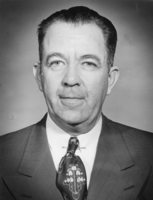 | Back to e-WV
| Back to e-WV
 The West Virginia Encyclopedia
The West Virginia Encyclopedia
 | Back to e-WV
| Back to e-WV
 The West Virginia Encyclopedia
The West Virginia Encyclopedia

Okey Leonidas Patteson (September 14, 1898-July 3, 1989), tackled difficult decisions as West Virginia’s 23rd governor from 1949 to 1953 and became known as the “Great Persuader” from Mount Hope. His greatest legacy is the West Virginia University School of Medicine, which today one enters via four-lane Patteson Drive. According to John Morgan’s book, West Virginia Governors, Patteson left office more popular than when elected. He was the first West Virginian to overcome a severe physical handicap and be elected governor.
Patteson was born in Dingess in Mingo County. His parents, originally from Nicholas County, moved the family to Mount Hope in Fayette County when Okey was a child.
Patteson’s election as a Democratic governor coincided with the upset victory of President Harry S. Truman in 1948. During four years in office, Patteson wrestled with issues relating to the Korean Conflict, choosing the location for a state medical school, juggling bonuses for veterans of World War II, highway construction controversies, and a prison riot.
Following his education at West Virginia Wesleyan College and at Carnegie Tech (now Carnegie Mellon University) in Pittsburgh, Patteson launched a career in business and in 1923 married Lee Hawse from Romney. Tragedy struck in 1932 when the 34-year-old businessman was bird hunting with brother-in-law Karl Warden. Patteson had leaned his loaded 12-gauge Winchester shotgun against his car, thinking he had left the safety on. As he closed the left rear door after retrieving his gun case, the shotgun fell and discharged with a deafening roar, shooting Patteson’s feet from under him. Doctors at Beckley amputated both legs below the knees. During his six-week hospital convalescence Patteson was fitted with artificial limbs. Within four months, he was walking again and driving his own car.
His determination to overcome obstacles found new outlets in real estate and politics. He ran for Fayette County Democratic committeeman and later for sheriff, winning every election he entered. In 1944, he managed the gubernatorial campaign of Clarence W. Meadows. When Meadows won, he named Patteson executive assistant, a newly created position. Given the assignment of handling tough problems, Patteson mastered the art of persuasion and four years later was endorsed by Meadows as his successor. Defeating the ‘‘crown prince’’ and ‘‘organized machine’’ labels that branded anyone supported by an incumbent governor in those times, Patteson won the primary with more votes than the combined votes of his opponents. In the general election, he defeated state Sen. Herbert S. Boreman, grand-nephew of West Virginia’s first governor. An estimated 2,500 persons jammed the state capitol to hear Patteson’s inaugural address.
Patteson is best remembered for the politically tough decision of where to locate the state’s first medical school. The contest was between the metropolitan capital city of Charleston and the university community of Morgantown. After months of seeking advice, the governor opted for Morgantown as ‘‘the logical and best place for the location of the school,’’ insisting the weight of evidence favored location on a university campus.
Other newsworthy events during Patteson’s term included construction of the West Virginia Turnpike, although Patteson lost in federal court his argument that the turnpike should be four lanes instead of the original confusing two-and three-lane configuration favored by the Turnpike Commission. A veterans bonus was passed for West Virginia veterans of the two world wars. The penny-a-bottle ‘‘pop’’ tax was created to finance the medical school. A prison riot in 1951 was attributed to crowded conditions and idleness; no one was injured. An eight-story office building designed by capitol architect Cass Gilbert’s son and later occupied by the Division of Motor Vehicles was built for $4 million.
Patteson endorsed Attorney General William C. Marland as his successor, but later broke with Marland, saying his ‘‘faith was misplaced,’’ in that Patteson had considered Marland to be ‘‘strictly sober.’’ (By this time, Marland’s problems with alcoholism were a matter of public discussion.) Patteson’s work after the governorship was largely in real estate and banking. He served as president of Raleigh County Bank and was an original member of the Board of Regents, which oversaw higher education. He remained a popular figure in Democratic circles. ‘‘Being governor was a wonderful opportunity. I wouldn’t take anything for the experience. But I don’t think I would be interested in even trying to go through the ordeal again,’’ he said.
In 1961, more than six years after the death of his first wife, Patteson married Dorothy R. ‘‘Bebe’’ (Reuter) Warden, who had been a family friend for years. Patteson quietly visited others facing handicaps in hospitals, remembering long after 1932 a man with artificial limbs who had inspired him after his own hunting accident.
Written by Jack Canfield
Morgan, John G. West Virginia Governors, 1863-1980. Charleston: Charleston Newspapers, 1980.